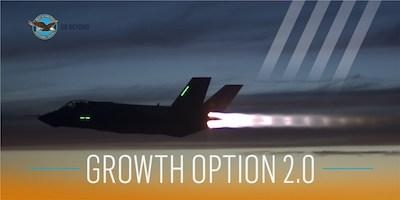Sun, Jun 17, 2018
Will Provide Increased Power And Thermal Management For F-35 Lightning II Aircraft
Pratt & Whitney has announced a Growth Option 2.0 upgrade for the F135 engine, which powers the fifth generation F-35 Lightning II aircraft, that can provide increased power and thermal management system (PTMS) capacity. The Growth Option 2.0 upgrade can be configured based on customer requirements to offer a range of PTMS improvements, an area which is emerging as a critical enabling capability for future block upgrades to the F-35 aircraft. The near-term iteration of this upgrade can provide a significant improvement in PTMS capacity.

"As the F-35 program moves forward with the Continuous Capability Development and Delivery (C2D2) strategy, we strive to stay in front of propulsion advances needed to enable F-35 modernization," said Matthew Bromberg, president, Pratt & Whitney Military Engines. "We're continuously assessing customer needs and responding with technology insertion options to keep them ahead of evolving threats."
Growth Option 2.0 incorporates the same suite of compressor and turbine technologies offered in the previously announced Growth Option 1.0, and also brings scaled advances in PTMS capacity while maintaining the same fuel burn (5-6 percent) and thrust improvements (6-10 percent) across the F-35 flight envelope. By selecting from Pratt & Whitney's full suite of technologies, F-35 customers can chose the magnitude of PTMS improvements as the mission requires.
Increases in PTMS capacity can enable the F-35 to utilize an enhanced spectrum of offensive and defensive weapon system technologies. Growth Option 2.0 can provide a significant improvement in PTMS capacity in the near-term by utilizing several low-risk technologies ready for Engineering and Manufacturing Development (EMD) today. Pratt & Whitney is also maturing additional technologies that are projected to provide even greater PTMS capability.
Growth Option 2.0 represents the next iteration of Pratt & Whitney's Future Adaptive Spiral Technology approach, which enables the timely insertion of next-generation propulsion technologies into current and future platforms. The foundation of this approach is a suite of adaptive engine technologies Pratt & Whitney is developing to meet the demands of range, persistence, survivability, maintainability and advanced weapon systems for the missions of tomorrow. These advanced technologies can be spiraled in as they become available and provide a full range of options for customers, enabling them to maintain the operational edge now and into the future.
"Our spiral approach allows Pratt & Whitney to offer rapid, iterative upgrades such as Growth Option 1.0 and Growth Option 2.0 that put next generation propulsion technologies into the hands of the warfighter as fast as possible," added Bromberg. "These upgrades are aligned with the F-35 C2D2 strategy and provide a range of options to meet future weapons system requirements for the F135 engine."
(Image provided with Pratt & Whitney news release)
More News
Terminal Radar Service Area Airspace surrounding designated airports wherein ATC provides radar vectoring, sequencing, and separation on a full-time basis for all IFR and participa>[...]
Very High Frequency (VHF) The frequency band between 30 and 300 MHz. Portions of this band, 108 to 118 MHz, are used for certain NAVAIDs; 118 to 136 MHz are used for civil air/grou>[...]
“From approximately November 2021 through January 2022, Britton-Harr, acting on behalf of AeroVanti, entered into lease-purchase agreements for five Piaggio-manufactured airc>[...]
Also: Virtual FLRAA Prototype, IFR-Capable Autonomous A/C, NS-32 Crew, Golden Dome Missile Defense Bombardier announced that the first production Global 8000 successfully completed>[...]
Aero Linx: The 1-26 Association (Schweizer) The Association’s goal is to foster the helpfulness, the camaraderie, and the opportunity for head-to-head competition that is fou>[...]
 ANN's Daily Aero-Term (05.29.25): Terminal Radar Service Area
ANN's Daily Aero-Term (05.29.25): Terminal Radar Service Area ANN's Daily Aero-Term (05.30.25): Very High Frequency (VHF)
ANN's Daily Aero-Term (05.30.25): Very High Frequency (VHF) Aero-News: Quote of the Day (05.30.25)
Aero-News: Quote of the Day (05.30.25) Airborne 05.23.25: Global 8000, Qatar B747 Accepted, Aviation Merit Badge
Airborne 05.23.25: Global 8000, Qatar B747 Accepted, Aviation Merit Badge ANN's Daily Aero-Linx (05.30.25)
ANN's Daily Aero-Linx (05.30.25)



